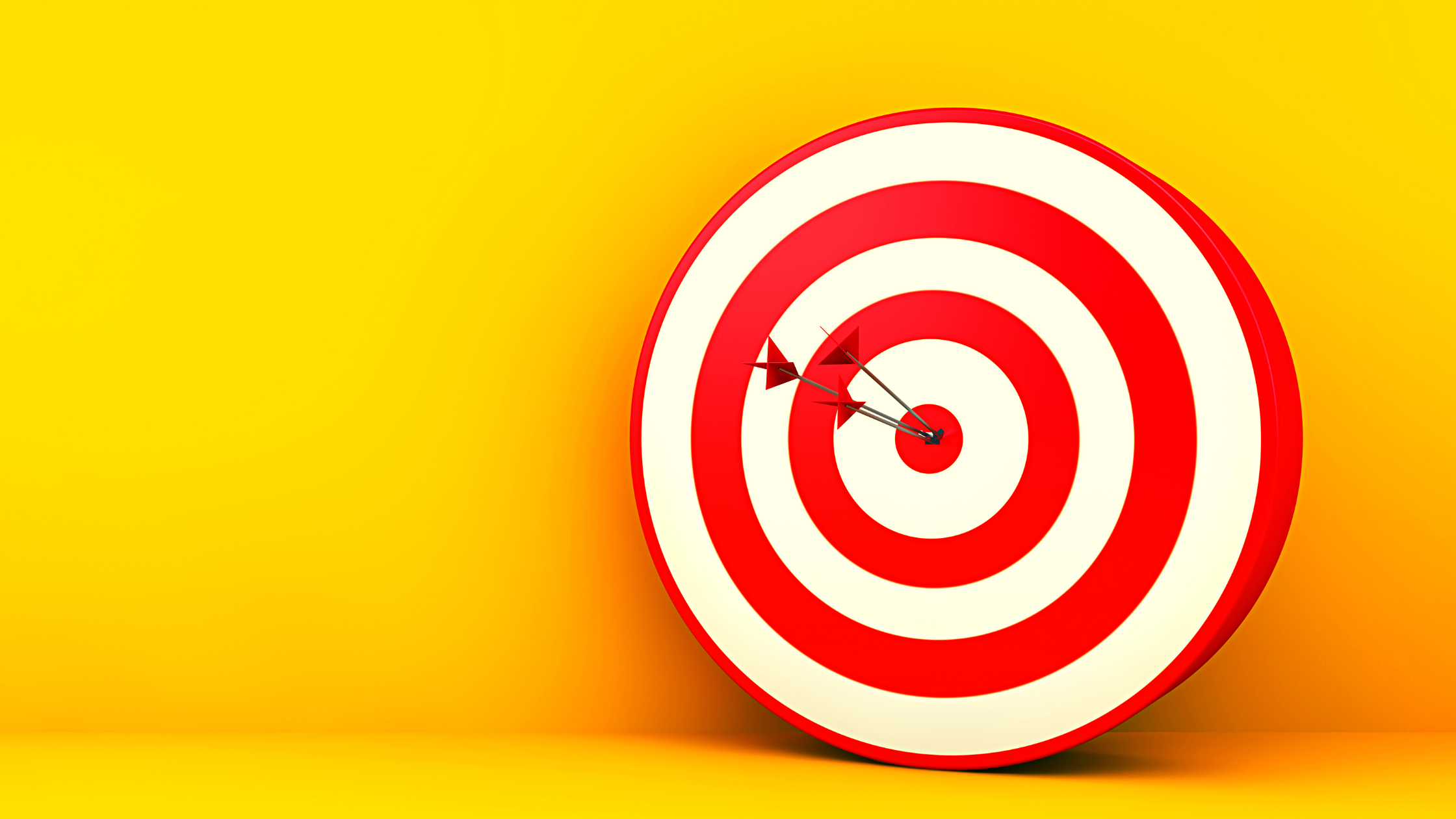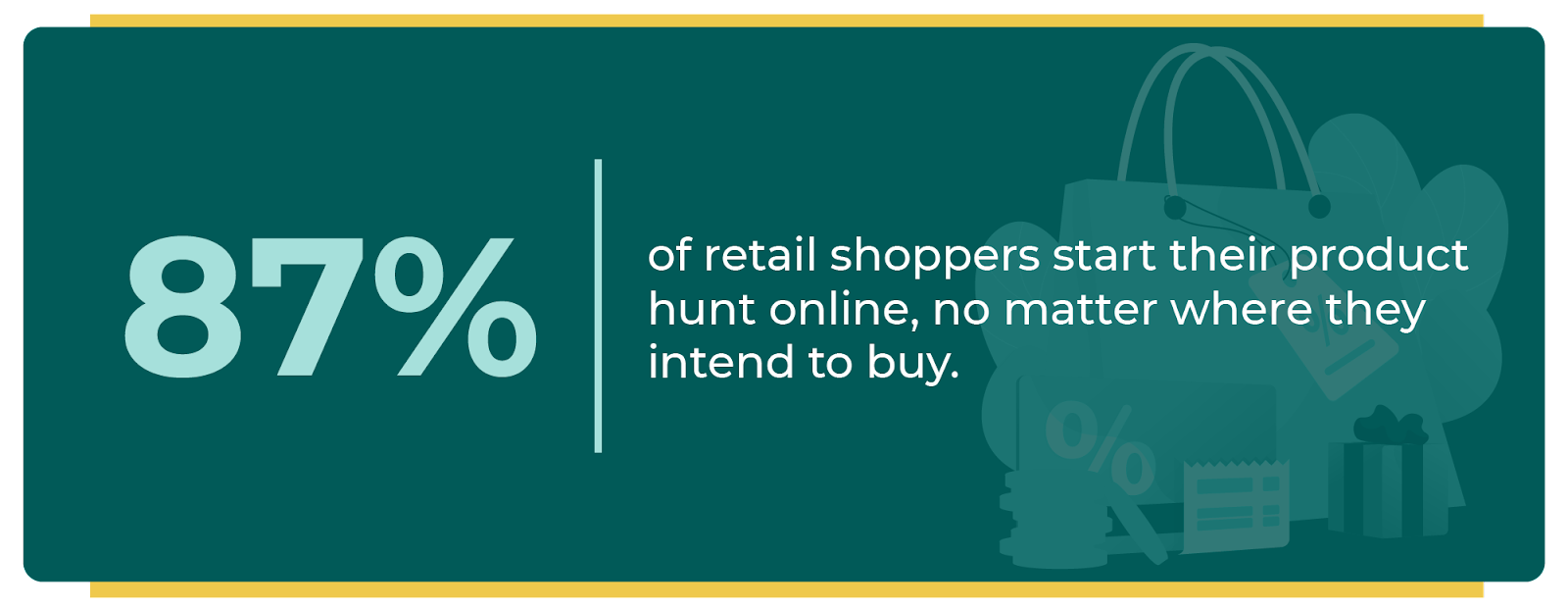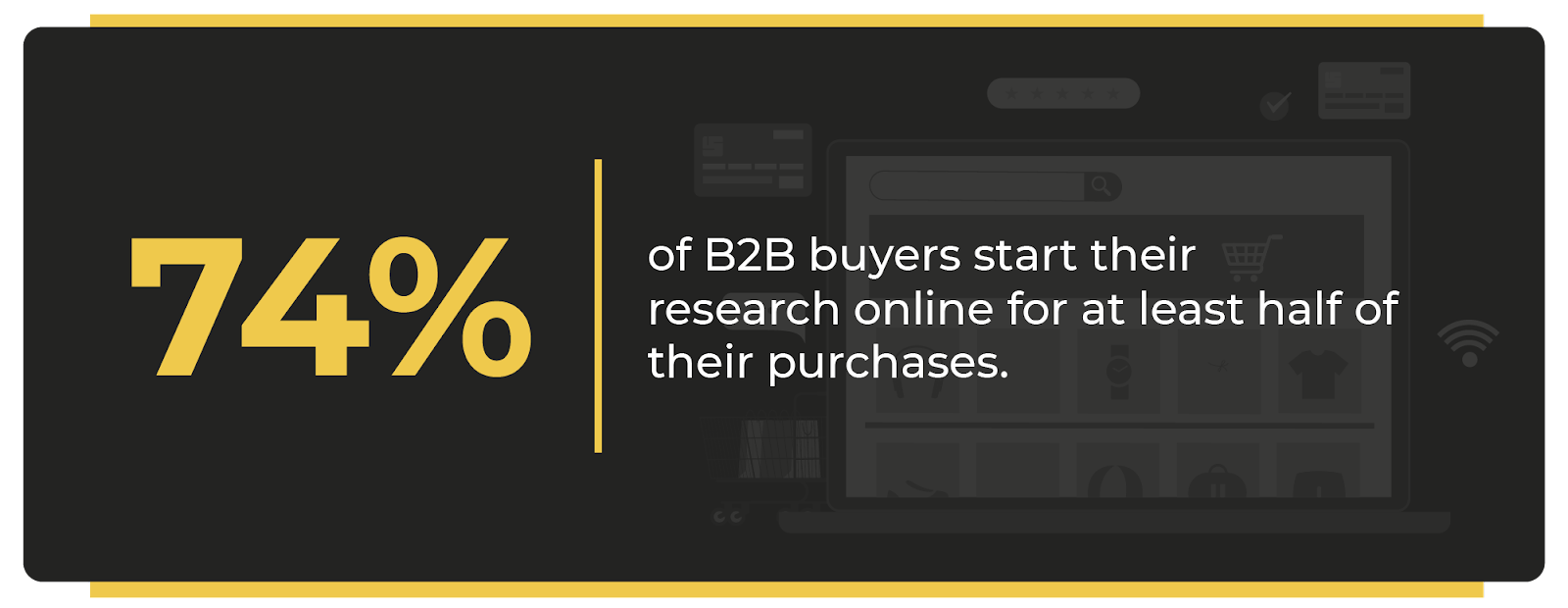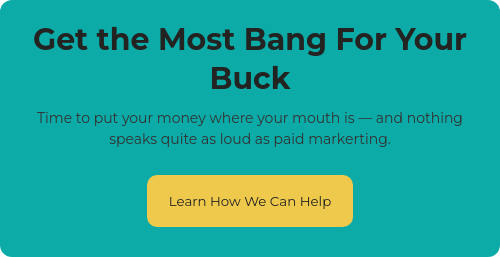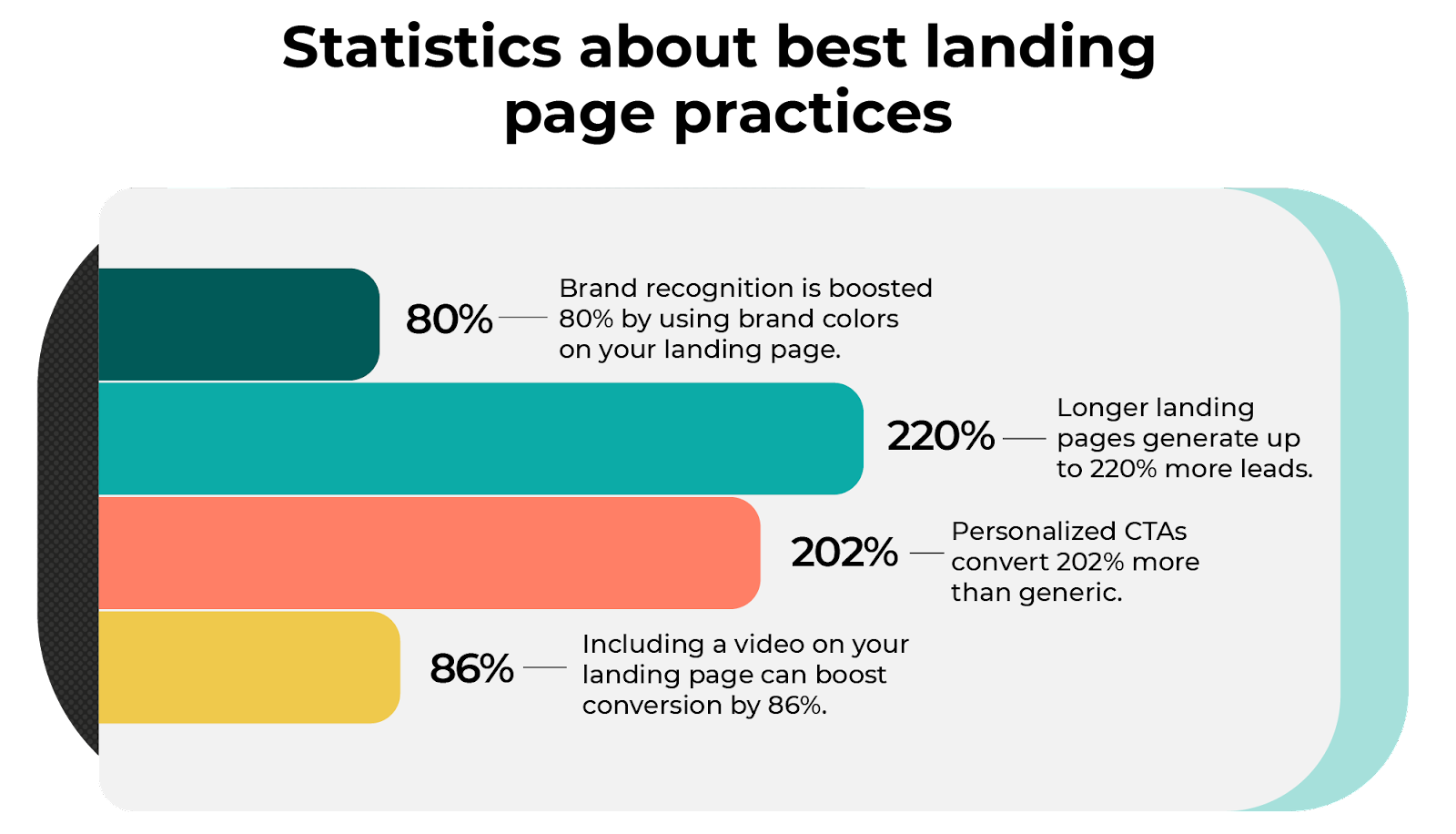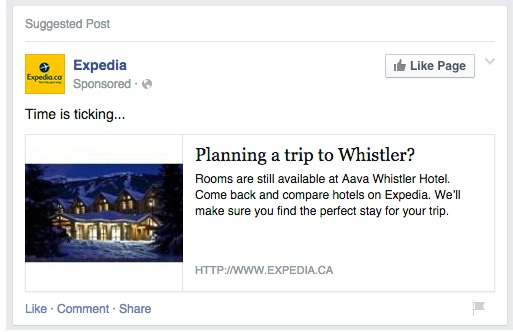A few years back, plenty of shoppers were researching their purchases online. That is, if they were planning to make the purchase online. But the times, they are a’changing, and after the last couple years, more shoppers are turning to search engines to begin their buyer’s journey…no matter where they actually plan to make the purchase.
The same is true in the B2B world, where purchase decisions can take a longer period of time, and most B2B buyers want to navigate the experience without sales or customer support intervention.
So, how do you make sure your brand is one of the first to pop up when a shopper is looking for what you’ve got to sell?
Paid advertising.
It gets a bad rap sometimes, especially from organic and inbound marketers (who, us?), but paid ads are great to give you a quick growth injection, especially while you’re waiting for your SEO to and other organic strategies to rev up.
Let’s learn more about paid advertising and how you can craft a strategy to drive insane growth for your brand.
What Is Paid Advertising?
It’s all in the name. Technically speaking, paid advertising could be any media you pay for, including broadcast and print. But what we’re talking about is digital paid marketing, of which there are many types.
- PPC: Pay-per-click advertising is exactly what it says. Users click on your ads and you pay each time. Many kinds of paid ads can be PPC, but though often used interchangeably, PPC is just a part of paid advertising.
- Search ads: Paid search ads appear at the top of SERPs (search engine results pages), above the organic results.
- Paid social: Nearly all social platforms offer an advertising platform. There are many types of ads within each, and they’re most effective when paired with an organic social strategy.
- Display ads: These are the ads you see when navigating across websites. Usually they appear as banners or sidebars. Google Display Network is one of the most popular choices for display ads.
- Native ads: Native ad platforms place your ads on different websites. The key differentiator is that these ads are designed according to the look and branding of the website, so it appears to live there “natively.”
So why should you choose paid advertising? Let’s find out.
Benefits of Paid Ads
So you threw yourself into organic SEO. You set goals, you built a strategy, and you started implementing optimization across your website and your content. Now, it’s been moooooonths, and you’re starting to wonder if it was worth the effort.
It will be. But SEO strategies can take 9-12 months to deliver meaningful results, and there’s no reason to just twiddle your thumbs while your brand limps along. Instead, incorporating a paid ad strategy will bring you fast, short-term results that will give your brand a lift while you wait.
When you combine strategies that come to fruition at different times, you’ve got a recipe for success.
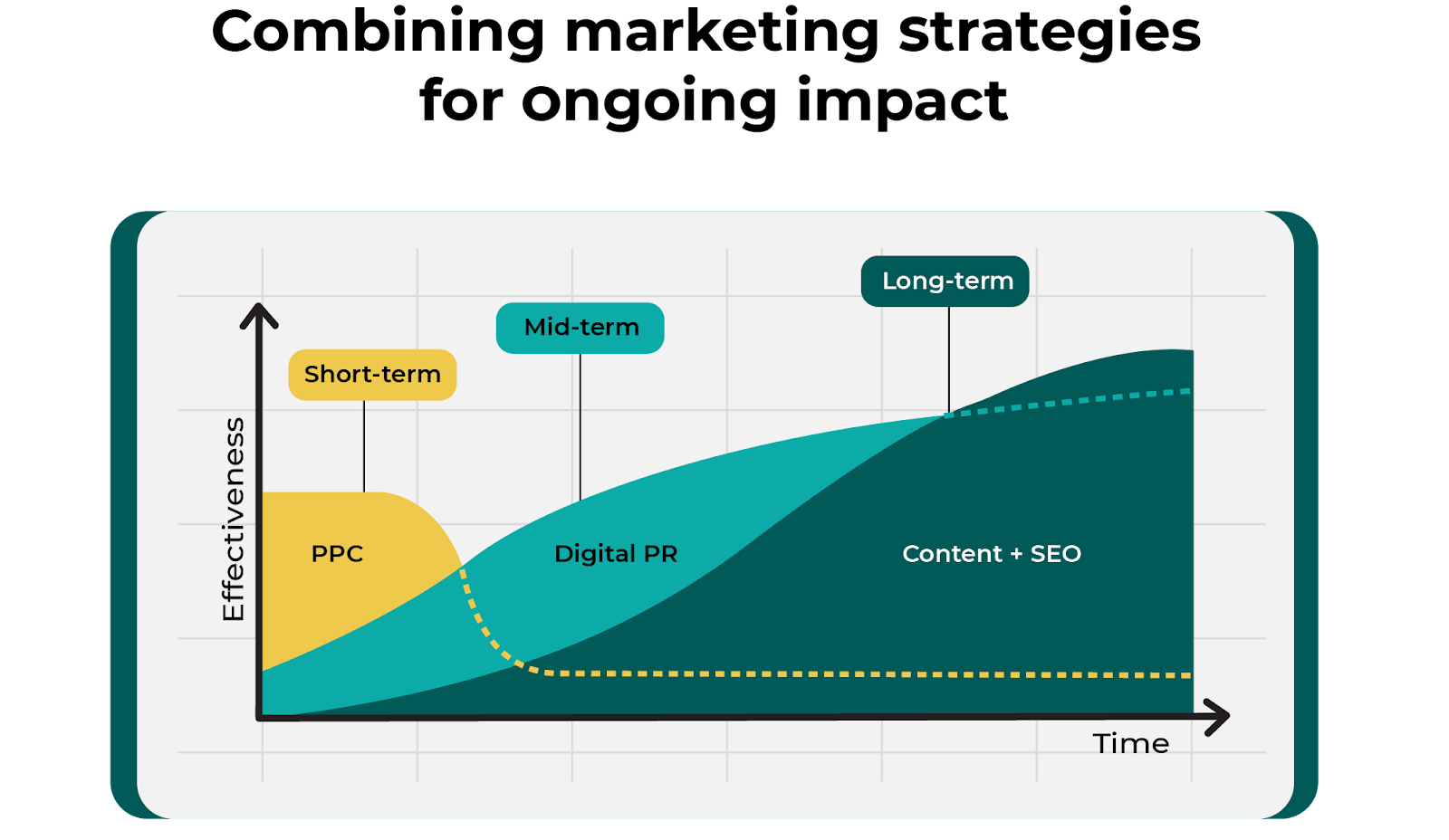
Need more to convince you that paid advertising is the right move for your brand? We’ve got you covered.
Strong ROI
With paid ads — PPC in particular — you really get what you pay for. Meaning that you only pay when a user clicks on your ad. Your budget is in your control at all times, so you know that when money’s going out, results are coming in. You can’t really get this type of instant ROI with any other marketing strategy.
Test profitability of multiple audience segments and keywords
Paid ad campaigns are highly adaptable and extremely flexible, so if something isn’t working, you can shift on a dime. This also allows you to A/B test different ads, trying out unique headlines, visuals, CTAs, and more. When you need to make a change, try adjusting your targeted audiences and/or your keywords to find a path to the right people and a message that resonates.
Only pay when a user clicks your ad
Let’s say you buy a TV ad. You pay upfront for production costs and time slots you hope will get you in front of the audience you want. But if the spot never really hits the right viewers…? Well, too bad, because you already paid for it.
In contrast, with paid advertising, especially PPC, you only pay when someone clicks on your ad. And since you set the overall budget and CPC (cost per click), you’ll never spend more than you’re able.
Boost campaigns
Is your competitor outranking you in search? Maybe you have a high-performing organic post your followers love, and you want to reach a bigger market? Or maybe you’re ready to put a stop to abandoned carts with a retargeting campaign.
Whatever your goal, you can boost your brand’s signal through paid advertising. It’s the quickest, most efficient, and most cost-effective way to ensure your brand cuts through all the noise and gets in front of the right audience.
Get on top of Google quickly
Top organic positions on Google are highly coveted for a reason: The number one spot accounts for over 30 percent of all clicks, and the first page gets over 99 percent. But with so much at stake and all the competition out there, how can you move your brand up the SERPs?
Paid advertising, of course.
It levels the playing field with your competition and gives you equal footing. Even if they’ve been around longer and have put more time and effort into SEO, you can still outrank them with a great paid ad strategy.
Minimal impact after algorithm changes
Possum, penguin, pigeon…oh my! Wondering what these have in common? All were Google algorithm changes from the last decade. The algorithms frequently change, often with little warning, and it can be enough to completely dismantle even the most carefully laid SEO plans.
The same isn’t true for PPC. You pay for the clicks, and Google delivers. So, no matter how many “P” animal updates they throw at you, you’ll always come out on top.
Affordable for certain industries
Depending on your industry, you might find that paid ads are the most budget-friendly option for quick growth results. When it comes to cost-per-click, the legal field is the highest and most competitive, followed by consumer services and finance. But on the flip side, ecommerce is one of the lowest-cost industries, along with automotive, travel, and B2B.
High return on investment
The beauty of PPC is that you’ll see your ROI right away. Once a campaign launches, you’ll know pretty much immediately if it’s delivering results. That means that, if it’s not, you can take swift and decisive action to change your ads until you find what works. Test and experiment until the ad takes off, and then you’ll see your ROI soar.
Improve retargeting
When a user clicks on your ad but doesn’t convert, you might think it’s a loss, but in reality, it’s just another opportunity for a big win. You already know they saw something they were interested in enough to click — so a retargeting ad designed to show them what they’re missing is far more likely to get them to take action.
Compete even as a new business
Paid advertising allows brand-new businesses to level the playing field and take on even the toughest competition. Pay-to-play means that if you have the budget, you can guarantee a prime location. PPC isn’t impacted by your organic search rankings, so even though you should be working on a long-term SEO strategy, it won’t affect the success of your paid campaigns.
Improve brand recognition
Even if you aren’t getting as many clicks as you want right away, you can still benefit from a PPC campaign. Every time an ad is placed, more people are being exposed to your brand. Keeping your brand in front of more eyeballs and keeping it top of mind through PPC will improve your brand recognition, whether users are clicking or not (and if they’re not, test and make adjustments until they do).
5 Popular PPC Advertising Strategies
Okay, so you’re sold on the benefits of paid advertising. Now what? Now you put together a PPC strategy that will drive your campaign and bring quick new growth for your brand. Here’s how you do it:
1. Establish SMART goals for paid advertising
You can’t reach those big goals if you don’t know what they are. PPC is extremely satisfying in that if you do it right, you’re sure to meet many, if not all, of your goals. But first, put your thinking caps on because your PPC goals need to be SMART.
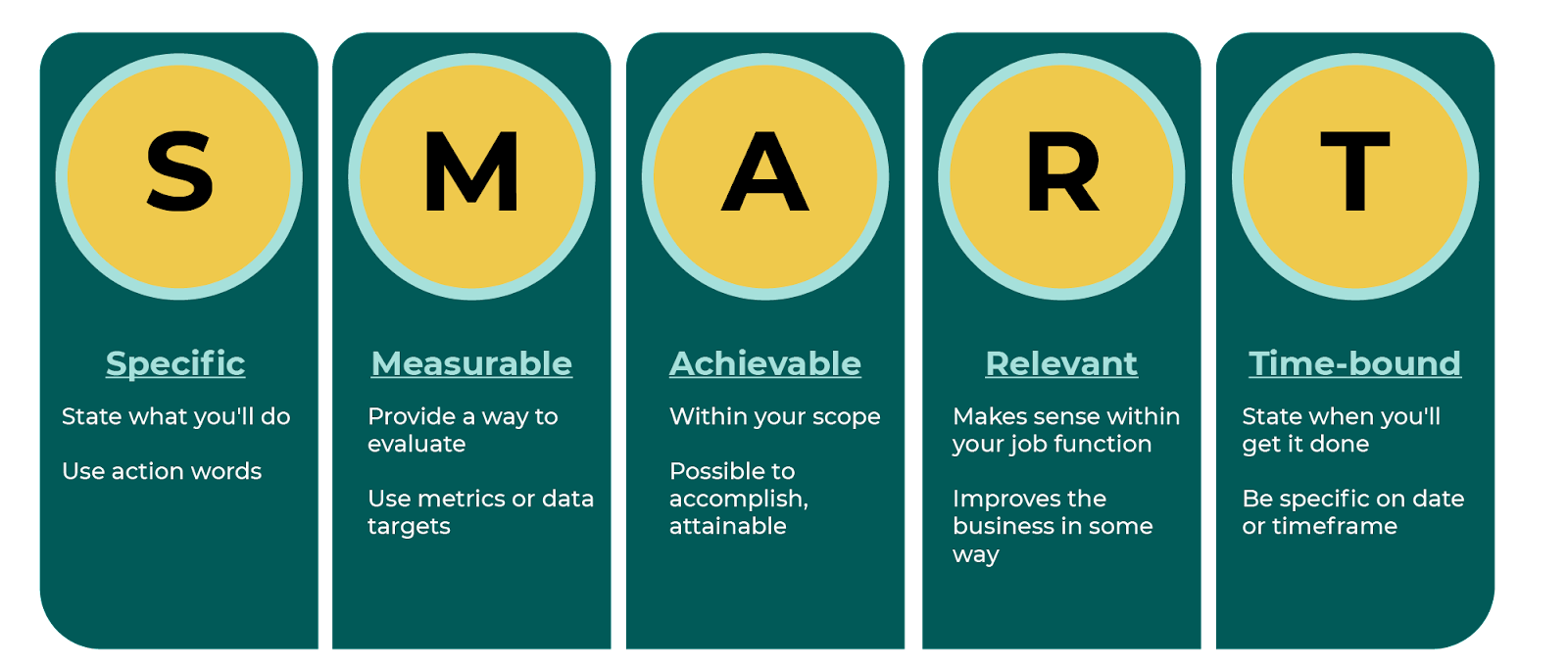
2. Understand the elements of a highly successful PPC campaign
What makes some PPC ads perform better than others? Let’s say we have two ads that appear in the same network, on the same pages, to roughly the same audience. One gets clicks, and the other doesn’t. What gives? The one getting the clicks probably utilizes the five elements of a successful PPC campaign.
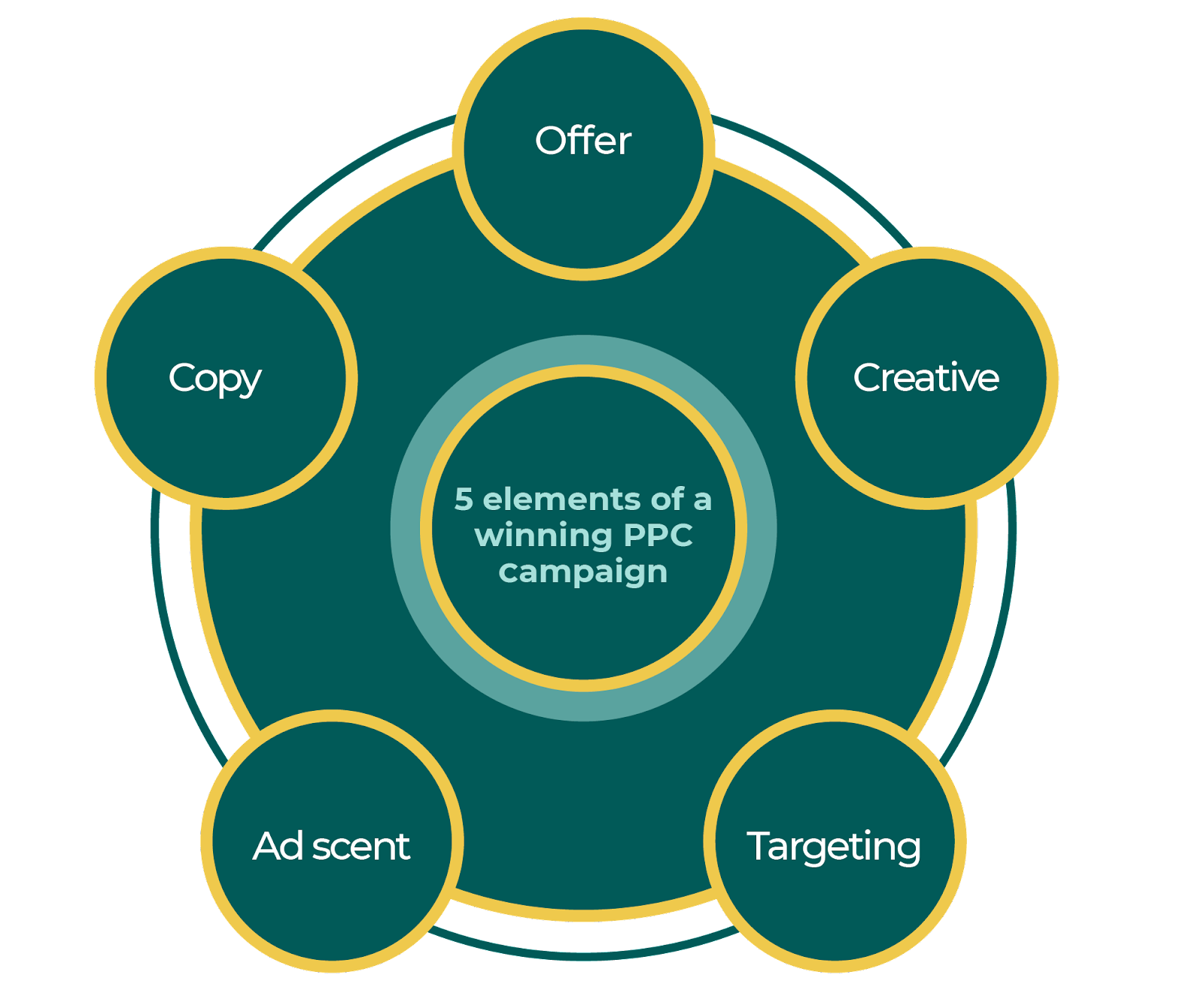
Offer
Your offer is not just your product or price — it’s a combination of factors that will appeal to your target audience (hopefully enough to make them click). You could offer a BOGO deal, a first-time customer deal, a limited-time discount, or an ad-exclusive deal. Whatever it is, it has to be strong enough to compel users to take action. Simply displaying your product isn’t enough.
Copy
The copy in your PPC ad includes all the text in and around your ad. You don’t get much space, and every text area comes with a strict character count. So you’ll need to make every word count. Start with a compelling headline that hooks the audience, and make sure your offer text leaves them no choice but to click.
Creative
This refers to all of the visual elements in your ad, whether it’s an image, a carousel, or a video. Often, you’ll want to be pretty on the nose with your creative, showcasing an image of the product or service you’re selling. Stock photos should be used sparingly and chosen carefully. Consider the colors you use, and make sure you don’t clutter up your graphic with too much text (Google may ding you for that).
Ad scent
Ad scent basically means having enough consistency in your ad campaign that your audience can stay on your trail. That means that from the very first ad, everything flows in a logical and congruous way. To improve ad scent, make sure you’re using similar creative (colors, graphics, copy, etc.) across your landing page and any additional campaign elements. Also be sure your offer is the same from beginning to end — if users get a whiff of bait and switch, they’ll bail.
Targeting
The best product and the best offer seem to be a pretty dynamic duo. But even that killer combo won’t get sales if they aren’t hitting the right audience. This is where your research into your buyer persona will come in handy, as PPC allows you to get pretty granular with your targeting. Be specific, and always consider your specific audience and the goals you want to hit when putting together your messaging.
3. Create landing pages
Your landing page is every bit as important as your ad. Your ad hooks the visitor while your landing page cinches the deal. Need some convincing on just how critical it is to nail your campaign landing page?
When building your landing page, remember these key tips:
- Only one offer on the page (and it should be exactly the same as the offer in your ad).
- Use A/B testing to try out different headlines or CTA until you find what converts.
- Include a strong, clear CTA that drives visitors to take one singular action.
4. A/B test your ads
In addition to your landing page, you’ll also want to A/B test the actual ads. Running an ad with a variation allows you to make strategic adjustments and find the right combination of the five elements above that lead to greater conversion.
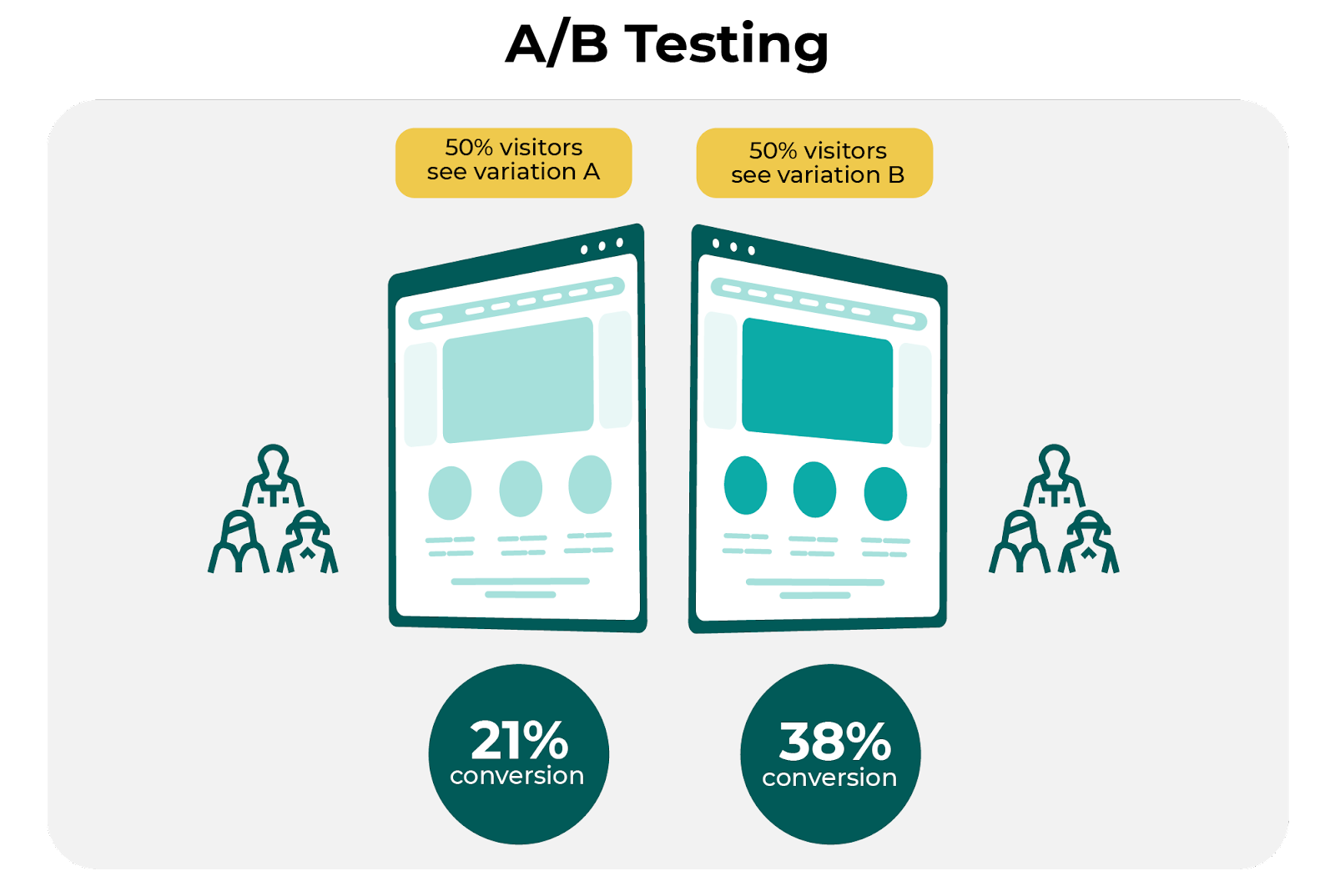
The biggest trick to successful A/B testing is to only test one element at a time. If you change both the headline and the visual, how will you know which caused your results to soar (or sink)? Instead, try two variations of the headline. Once you know which one works best, combine that headline with two variations of the ad creative, and so on. Eventually, you’ll find the winning combination.
5. Track and review ads regularly
The great thing about PPC is that you see results in the moment, so you can swiftly make adjustments. However, you want to avoid checking daily (or hourly) because otherwise, you won’t notice trends over time and may jump to a hasty conclusion.
Instead, plan to review ad performance at regular intervals, such as once a week. This way, you’ll get a sense of how the ad is performing over a period of time but still have time to change it relatively quickly if it isn’t bringing you toward meeting your goals.
Examples of Paid Advertising
There are many types of paid advertising, and it’s likely that you can find one that fits your goals, your budget, and your brand. Take a look at these examples, and find out how to implement a strategy for each.
Search advertising
Search ads appear when a user searches for something that triggers your keywords. Your ad is served up right at the top of the search engine results page (SERP), above the organic results. Paid search ads are always clearly marked with the word “Ad” before the listing.
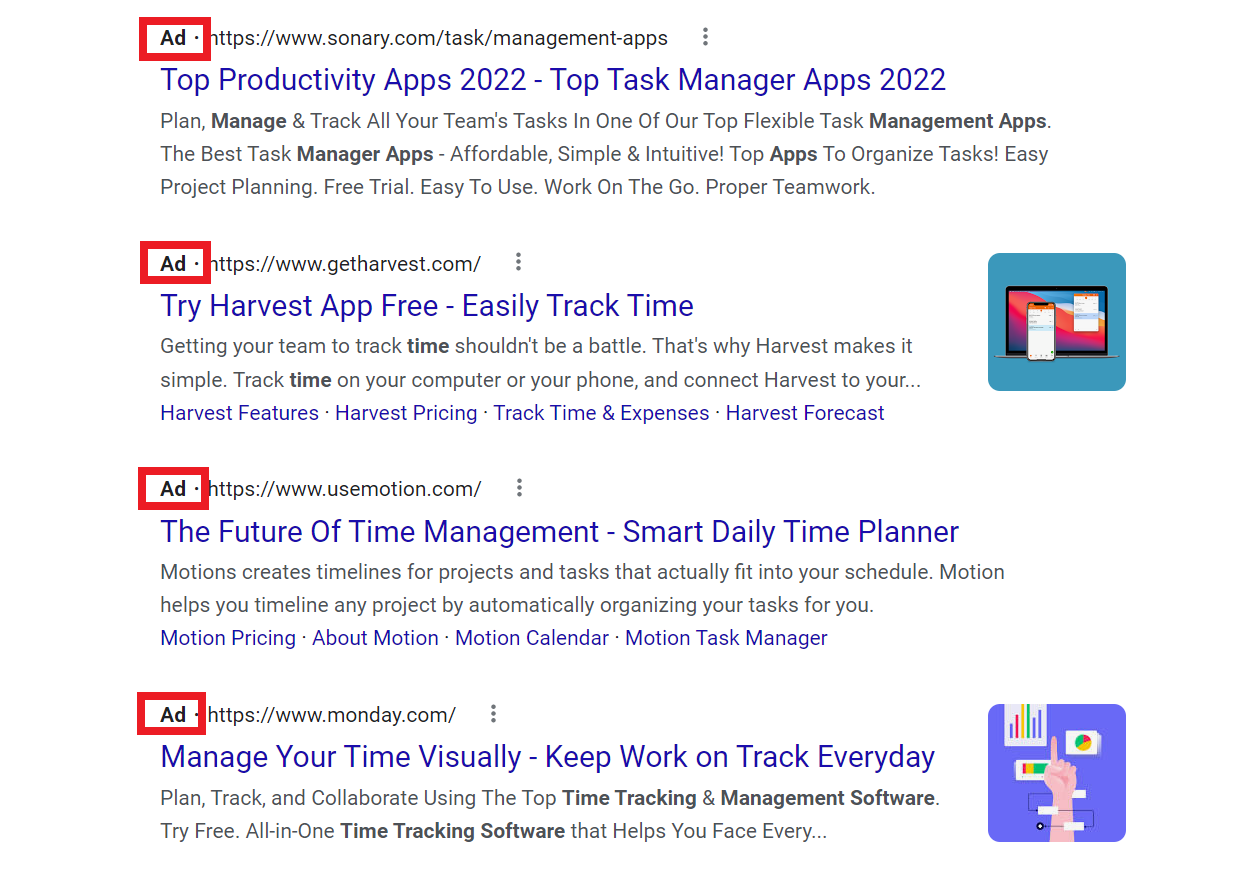
Search advertising strategies
If you decide that search ads are the way you want to go, here’s everything you need to put together a strong campaign that delivers results:
Optimize landing pages and ensure they're relevant to the ad
As mentioned above, an amazing ad isn’t enough to get conversions. You have to follow it up with an equally amazing landing page. Be sure your landing page is optimized to carry the “ad scent” further down the trail. It should have the same offer as your ad, consistent branding, and one single CTA to move visitors along and encourage them to take the desired action.
Use negative keywords
So, you know what people are searching for to find your brand. But do you know all the other keywords that lead the wrong visitors there by mistake? These are your negative keywords — the ones you might rank for but which are irrelevant to your brand and your goals. You can find these in your Search Terms report in your Google Ads dashboard. Check for any that don’t fit your search intent, and add them to your negative keyword list.
Target long-tail keywords
Targeting the highest-volume keywords will certainly get more eyes on your ad, but it doesn’t guarantee more clicks (and certainly not more sales). That’s fine if you’re looking only for brand awareness, but if you want conversions, you want to focus on long-tail keywords. These are the search phrases that are more specific and more targeted. These high search intent keywords are used by those who want exactly what you’re offering, so they’re far more likely to click and convert when they see your ad.
Use relevant ad extensions
Extensions can be added to your search ads via your Google Ads dashboard. You can choose to add your location, phone number, products, or relevant sales. It’s an absolute necessity if you’re a local business, but it can also be valuable to brands who supply products to other retail outlets, as you can include them in an affiliate extension.
Adjust your bids for geotargeting
Geotargeting isn’t just for local businesses. It pays to think through your strategy for targeting audiences in the geographic locations most likely to convert. For instance, if you sell a SaaS product for tech companies, you’ll likely want to geotarget tech hubs like San Francisco or Austin. If you sell rain boots, you may want to negative bid in desert areas during the driest months. You’ll also likely find that large metropolitan areas cost more, but don’t provide an adequate rate of conversions, so you might want to exclude them to maximize your budget.
Improve your quality score
Paying for a search ad gets you to the top of SERPs, so what more do you need? Well, in today’s competitive market, even a paid ad doesn’t guarantee a top spot. You’ll likely be among a handful of other advertisers, depending on how broad the market is and how fierce the competition is. The way to come out (for real) on top is to improve your quality score. Google takes a look at your ads, your landing pages, and your bids to generate a quality score of 1-10. The higher the score, the better you’ll rank.
Measure everything
Your Google Ads analytics will give you a good perspective on how your ad campaign is performing, but your own data will give you a better understanding of why. Make sure you understand where your website traffic is coming from, what pages perform well, and when visitors tend to bounce. Remember that growth hinges on experimentation, so let your data guide you to new tests that might drive better results.
Display advertising
Display ads usually appear as banners or sidebars on web pages. They are highly visual, with minimal copy, an eye-catching image, and a clear and simple CTA.
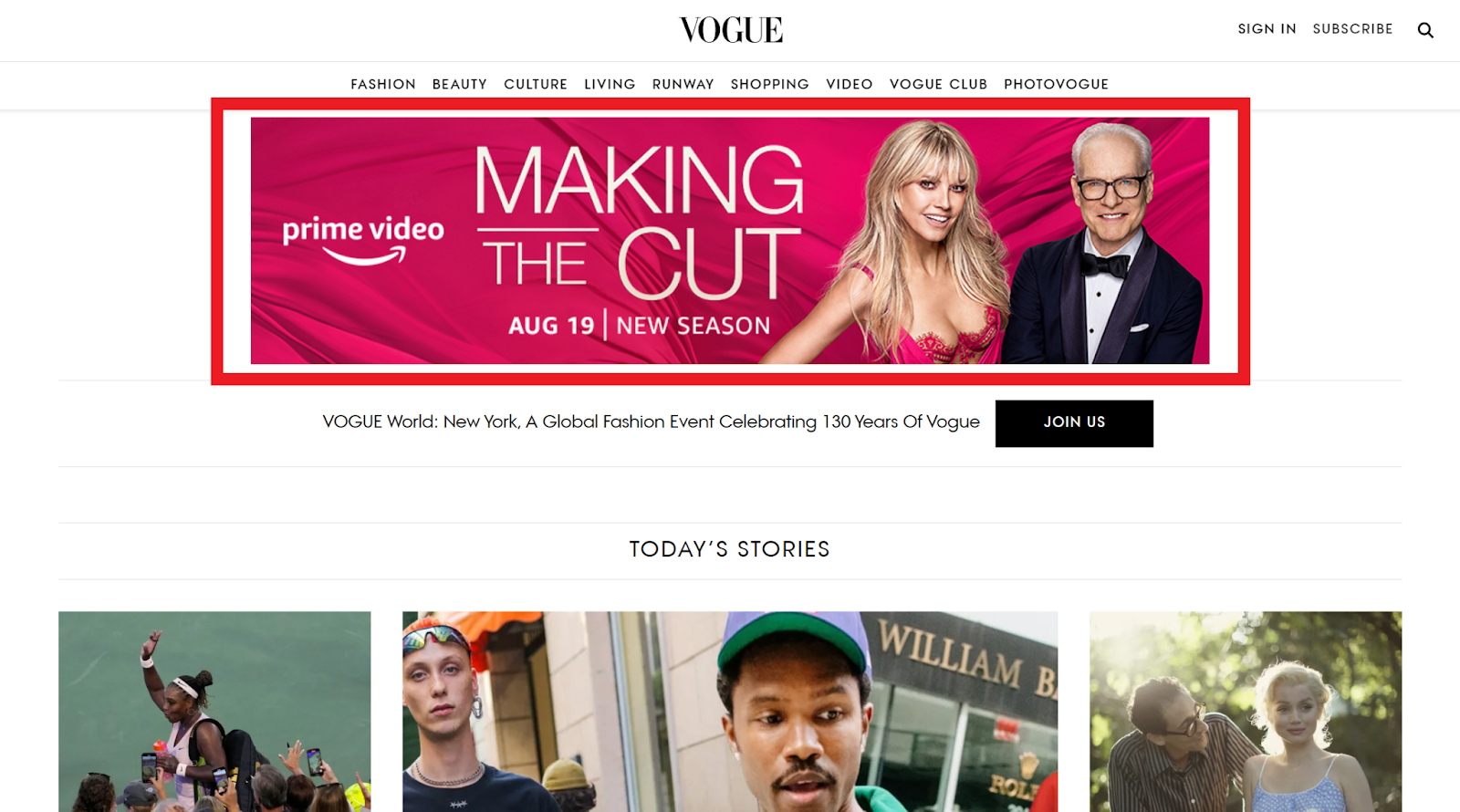
There are many display ad networks, though Google’s network remains the most popular. You can choose many kinds of display ads, such as the banner ad above, or you can opt for an interstitial (a popup ad the user must engage with before it clears the screen), a video ad, or a responsive display (which automatically adjusts to fit any size device or space).
Display advertising strategies
Ready to get started with display ads? Here’s what you need to know:
Zero in on your target audience
You should have a strong buyer persona by now. That will guide you as you hone in on the right audience for your ads, but there are many types of targeting that can further narrow the field.
Placement targeting allows you to select specific websites on which your ad will appear, while demographic targeting focuses more on the user. Topic targeting pulls in websites that fit in with a particular theme, and keyword targeting serves up ads based on what users have searched.
Create outstanding ads
Common sense, right? Not always. Some brands see PPC as a “quick and dirty” way to boost revenue, so they slap together an image and a half-assed headline and call it a day. That might work for a while, but users now are pretty savvy, and they know a crappy ad when they see one.
PPC deserves the same creative attention and consideration as your other marketing strategies. That means designing a visually appealing image, writing strong copy, and optimizing every step of the campaign to look and feel the same.
Optimize images and logo
According to Google, your logo should include your brand name and be as clear and simple as possible, with a 1:1 or 4:1 aspect ratio. Be sure the primary image in your ad is high quality, with 1.91:1 or 1:1 aspect ratios. Steer clear of image collages, too much overlaid text, or too much blank space.
Use compelling headlines and text to capture clicks
Text should always be short and snappy, but it shouldn’t be so vague that visitors are left wondering what the ad is even about. Here’s what Google says are good and bad examples of ad copy:
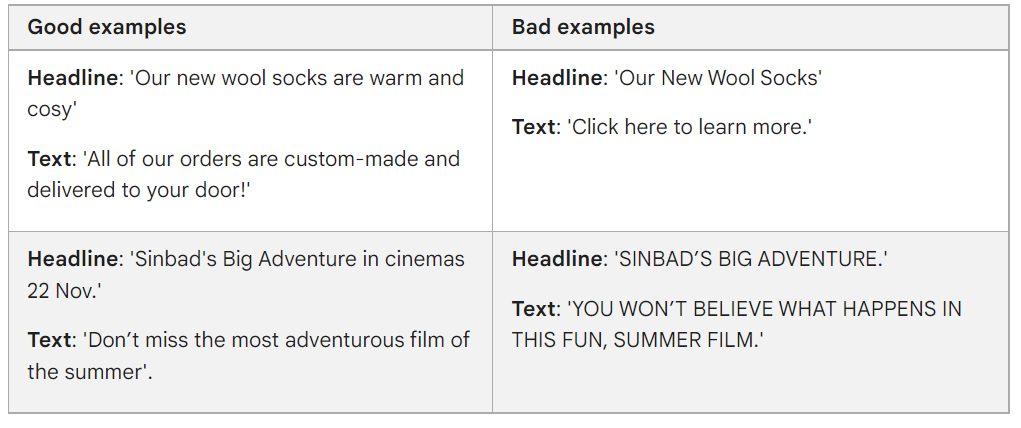
You’ll only have about 80-90 characters for your text, so you need to make every word count.
Use managed placements
As mentioned above, placement targeting allows you to decide the exact websites on which your ads will appear. This allows you to reach a very specific audience of people who will find your ad relevant. Placement targeting, when done well, can lead to a much higher conversion rate.
Start by identifying a handful of domains that are relevant to your brand, and begin your targeting on those sites. Branch out as needed, but remember that when you do demographic and topic targeting, you’re leaving all the decision-making in Google’s hands.
Diversify ad format
Think you don’t need text ads because most people prefer image ads? Think again. On some sites, text ads may be the only placement you’ll get. It’s important to create varying ad types so you ensure you have something ready to serve up when a spot becomes available. Ideally, create at least one ad for each format.
Run remarketing ads
Remarketing, or retargeting, ads are the quickest way to see a return on your display advertising budget. That’s because you’re hitting users who’ve already visited your site, so you know they’re familiar with your brand, they’ve shown some interest, and they won’t be as likely to be skeptical or turned off by seeing your ad on another site. In fact, retargeting is so effective on display that it would pay to make it your first campaign!
Use contextual targeting
Google offers a handy contextual targeting tool that will help ensure that your ads are getting served up on websites that are relevant to your audience. This, in many ways, is a mashup of keyword and topic targeting. All you do is input a keyword (a high-intent, long-tail keyword is best), and Google will generate a list of related topic keywords and suggest bids.
Remember that you don’t have to follow Google’s recommendations blindly — instead, use it as a starting point to develop a highly relevant list of targeted websites for your campaign.
Social media advertising
There are many, many different forms of social media ads out there, but the general strategy is the same, no matter which platform or ad format you choose. Social ads are highly engaging and allow for niche targeting so you can hit the exact right audience with the exact message they want to hear.
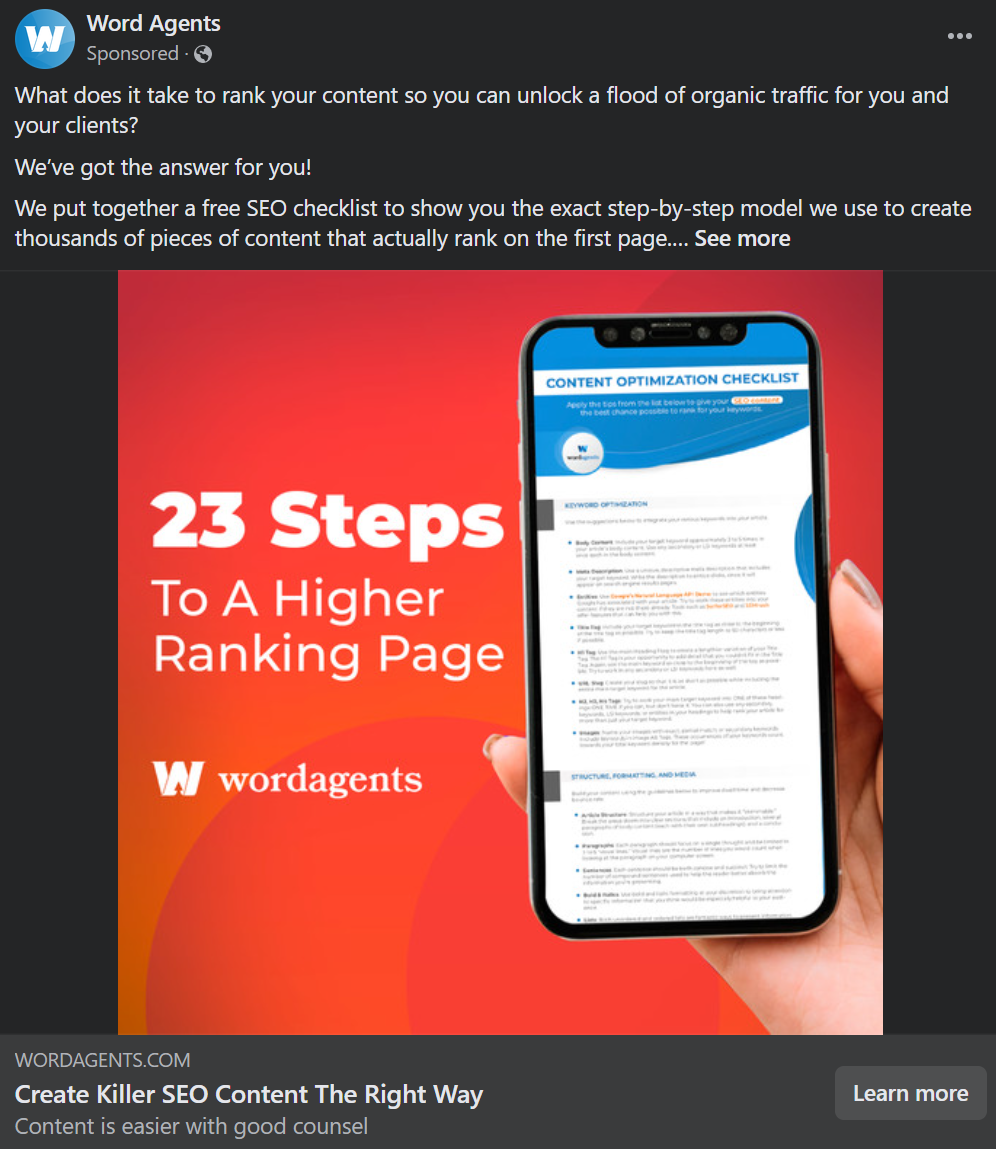
Paid social media strategies
So, how do you begin a paid social campaign? The first step is to hang out where your audience is. If they’re mostly professionals who are looking to talk about their favorite B2B SaaS solutions, you’ll probably find them on LinkedIn. If they’re Gen Xers sharing kid and pet pics, they’re probably on Facebook. Gen Zers posting selfies? Look to Instagram. It’s important you know where your audience is and start to establish a brand presence there before you launch paid social. Once you’re ready, here’s how to put together your strategy:
Define your target audience
Social media is an endless cavern of personal information just waiting to be mined. Your customers are out there, and they’re telling you everything you need to know to market to them effectively. Before beginning your paid campaign, take some time to research your audience — either your existing followers or those that follow your competitors. The insights you glean here will help you narrow down your targeting and create your ultimate social media buyer persona.
Determine objectives
What do you want out of your paid social campaign? Look back at the goals you set early on in your paid advertising planning and see if there’s a way to achieve them through social ads. Are you hoping to get as much traffic to your website as possible? Or do you want more qualified leads? Your goal will help guide your strategy — from choosing a social platform to crafting the messaging and creative for your ads.
Use creative variation to prevent stale ads
Similar to what you would do with display or search ads, you’ll want to have different versions of your social ads to find the right combination of elements that work best to drive results. Some recommend up to four variations of each ad. The algorithm for the specific platform’s ad program will choose with variation to display, and you can check the analytics to make adjustments as needed.
Get inspiration from successful campaigns
Keep your social media ads fresh and relevant by drawing your inspiration from other campaigns that are getting it right. Check out your competition and pay close attention to how much engagement they get from their ads. You can also check Meta’s Ad Library to search through past and present ad campaigns across all Meta platforms. Simply type in a keyword that’s relevant to your brand or industry, and browse through the results.
Use analytics to track and improve social media ads
Whichever platform you choose, it will come with its own pretty robust tracking and analytics. This is a great starting point, but you’ll also want to track your website traffic, time spent on page, bounce rate, and more to be sure visitors aren’t dropping off after they click your ad. If they are, it’s time to adjust your ad and reoptimize your landing page, offer, etc.
Post regularly
Paid social can sometimes fall a bit flat if you don’t already have an organic presence on a particular platform. You’ll want to make sure your brand page or profile is updated consistently with non-ad content. You’ll also want to engage with followers to build your brand reputation, encourage sharing and create an organic social strategy that supports and boosts your paid strategy.
Repurpose and recycle content
This is probably the easiest and most effective way to use content, whether it’s on your brand blog or on social media. Update older content and repost it to reach a new audience, and recycle your high-performing posts across social media platforms. It’s a great way to get the most out of your content for the least amount of money and time.
Retargeting ads
Retargeting ads are served up to those who’ve already clicked on one of your ads or visited your website. You know they’re interested. A retargeting ad is your second chance to make the right impression. Retargeting ads can also be reminders of a limited-time sale or deal about to expire, abandoned cart messages, or just a gentle nudge to come back.
Retargeting ads strategies
You can use retargeting ads in pretty much any form of paid advertising, and it’s one of the most effective ways to improve conversions. How do you get started? Let’s find out:
Understand the buyer journey
You want your retargeting ads to hit those who already have some level of familiarity with your brand. Where they are in the buyer’s journey will influence the kind of messaging you want them to see. If they’ve only just encountered your brand recently, they probably haven’t made it to the consideration stage, so pushing them to make a purchase might be off-putting.
On the other hand, if they’ve reached the purchase stage and you’re hitting them with generic brand awareness ads multiple times, they’re equally as likely to get frustrated. Know where they are so you know how to reach them.
Monitor advertising frequency
How often your ad hits the same audience has a direct impact on how they feel about your brand and whether or not they eventually make a purchase. When it comes to retargeting ads, less is more. In fact, after three repetitions, consumers feel annoyed. It starts to feel intrusive, and eventually, if they see an ad 10 or more times, they feel downright angry. Make sure your ads are hitting the same people only a handful of times. Then, change up your creative or pull your ad until you have a new one ready to roll.
Increase your network reach
At some point, you may have to go beyond Google. Meaning, if you want to expand your retargeting efforts, you want as much ad coverage across the internet as possible. Google Display Network can take you pretty far, but if you really want to be sure your potential customer is retargeting no matter where they go online, you’ll need to look into other display networks.
Optimize your conversion funnel
If you want to see results rolling in, you’ll need to optimize, test, re-optimize, and repeat, ad infinitum. Start by A/B testing the entire conversion funnel, from your initial ad and offer through your landing page and call to action. Make one change at a time, scrap the losing variation, and start testing a new one.
Diversify the ask
Seeing the same ad is frustrating, but seeing the same offer over and over again is just as maddening. If a 14-day free trial didn’t hook them the first time they visited your website or the first time they saw your retargeting ad, what makes you think it’s going to get them the third or fourth time?
Changing your headline or background image is all well and good, but if the offer doesn’t hook them, those changes won’t make an impact. This is especially important when your retargeting ad is successful and a customer converts. If they keep seeing your ad pop up with the same offer, they’re going to assume you’re either out of touch or just don’t care.
Adapt campaigns to similar products
Once your retargeting campaign successfully converts a new customer, it’s easy to want to rest on your laurels. Avoid that temptation. The best advice now is to continue moving them through the buyer’s journey, from customer to loyal customer. Retarget them with other products they haven’t purchased but that might be relevant to their last purchase. For instance, a scarf that matches the hat they just bought or an online course that teaches them how to use the SaaS product they just signed up for.
Define and measure success
For retargeting campaigns, success is usually measured by the number of conversions. However, keep in mind that conversions aren’t always sales. You might consider someone filling out a lead gen form a conversion. Whatever your idea of success is, make sure you’ve outlined the KPIs you want to track throughout the campaign.
Return on ad spend (ROAS) is usually a pretty critical one, but again, if your idea of success isn’t aligned with revenue, you might be better off tracking another metric.
Review, Reassess, Strategize Often
When it comes to PPC or any type of paid advertising, there’s never really a point at which you’re “done” (unless, of course, your budget runs out). As long as you’re paying and you have active campaigns, you should still be monitoring and adapting your ads and your overall paid strategy.
One way to do this — without blowing the budget or burning out yourself or your employees — is to trust your PPC campaigns to a reliable and experienced partner agency. And what better agency than one that’s entirely focused on growth and understands the benefits of testing and experimentation?
At FPS, we combine a bit of research, a lot of growth marketing, and a ton of data-driven decision-making to deliver crazy (good) results. We believe PPC can be part of an effective growth marketing strategy.
